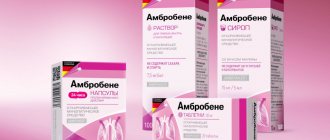Dimephosphon®
Dimephosphone is taken orally after meals with water.
The course of treatment depends on the nature of the disease and lasts from 3 days to 2 months.
In complex therapy of the following diseases and conditions:
For acute and chronic cerebrovascular accidents, consequences of ischemic and hemorrhagic strokes,
traumatic brain and neurosurgical trauma
for adults, 15 ml (1 tablespoon) 3-4 times a day. The duration of the course is 2-3 weeks, in some cases up to 6 weeks.
During planned neurosurgical operations
15 ml (1 tablespoon) for 5 days before and 2 months after surgery.
For osteochondrosis
adults: 10 ml (1 dessert spoon) 3-4 times a day for 2-3 weeks, improvement is observed on the 8-10th day of treatment.
For multiple sclerosis
adults: 100 mg/kg (45 ml) per day - 15 ml (1 tablespoon) 3 times a day for 10 days in the autumn-spring period monthly.
For chronic nonspecific lung diseases with signs of respiratory and pulmonary heart failure
adults: 15 ml (1 tablespoon) 3-4 times a day. Course - 7-10 days. The use of dimephosphone does not relieve asthma attacks and does not affect the frequency of use of beta-agonist aerosols.
For vegetative-vascular dystonia of the parasympathetic type
adults 15 ml (1 tablespoon) 3 times a day for 2-3 weeks, children over 12 years old 50 mg/kg (10-15 ml) 3 times a day for 3 weeks.
For chronic cerebrovascular insufficiency due to atherosclerosis and hypertension
15 ml (1 tablespoon) 3 times a day for 2-3 weeks.
For migraine
15 ml (1 tablespoon) 3 times a day for 2-3 weeks.
For Meniere's disease
15 ml (1 tablespoon) 3 times a day for 3 weeks.
For respiratory diseases, acidosis, atonic bronchial asthma and hay fever
adults are prescribed 15-25 ml, children are prescribed 15-25 ml, children are prescribed a dose of 75-100 mg/kg: children under 3 years old - 5 ml (1 teaspoon), 3-8 years old - 10 ml (1 dessert spoon), over 8 years old - 15 ml (1 tablespoon) 3 times a day, in severe cases - 4 times a day for 4-5 weeks.
For atonic bronchial asthma in combination with hay fever
prescribed 2-3 weeks before the onset of deterioration and taken throughout the entire flowering period. For dosing, you can use the measuring cup included in the package.
Externally
For infectious-inflammatory-allergic diseases of the skin and mucous membranes
in the form of bandages, turundas and lotions with a solution daily for
3-14 days.
For complex treatment of acne
wipe the skin 3-4 times a day, apply lotions in the evening.
With erysipelas
- lubricate the inflammation area 3 times a day for 3-5 days.
On the area of seams and places where the knitting needles exit
Apply gauze pads soaked in dimephosphone daily for 7-14 days.
For the prevention of radiation mucositis
- gauze wipes soaked in dimephosphone are placed in the projection of the radiation beams 20 minutes before dose exposure.
Dimephosphone, 1 piece, 100 ml, 15%, solution for oral and external use
Inside
, after meals, with water.
The course of treatment depends on the nature of the disease and lasts from 3 days to 2 months.
In complex therapy of the following diseases and conditions:
For acute and chronic cerebrovascular accidents, consequences of ischemic and hemorrhagic strokes, traumatic brain injury
- adults 15 ml (1 tablespoon) 3-4 times a day. The duration of the course is 2–3 weeks, in some cases up to 6 weeks.
During planned neurosurgical operations
- 15 ml (1 tablespoon) for 5 days before and 2 months after surgery.
For osteochondrosis
— adults, 10 ml (1 tablespoon) 3–4 times a day for 2–3 weeks, improvement is observed on the 8–10th day of treatment.
For multiple sclerosis
- adults 100 mg/kg (45 ml) per day (15 ml (1 tablespoon) 3 times a day) for 10 days in the autumn-spring period monthly.
For chronic nonspecific lung diseases with signs of respiratory and pulmonary-heart failure
- adults 15 ml (1 tablespoon) 3-4 times a day. Course - 7–10 days. The use of Dimephosphone® does not relieve asthma attacks and does not affect the frequency of use of beta-agonist aerosols.
For vegetative-vascular dystonia of the parasympathetic type
— adults 15 ml (1 tablespoon) 3 times a day for 2–3 weeks, children over 12 years old — 50 mg/kg (10–15 ml) 3 times a day for 3 weeks.
For chronic cerebrovascular insufficiency due to atherosclerosis and hypertension
— 15 ml (1 tablespoon) 3 times a day for 2–3 weeks.
For migraine
— 15 ml (1 tablespoon) 3 times a day for 2–3 weeks.
For Meniere's disease
- 15 ml (1 tablespoon) 3 times a day for 3 weeks.
For respiratory diseases, acidosis, atopic bronchial asthma and hay fever
- adults are prescribed 15-25 ml, children are prescribed at a dose of 75-100 mg/kg: up to 3 years - 5 ml (1 teaspoon), 3-8 years - 10 ml (1 teaspoon), over 8 years - 15 ml (1 tablespoon) 3 times a day, in severe cases - 4 times a day for 4-5 weeks. For atopic bronchial asthma in combination with hay fever, it is prescribed 2-3 weeks before the onset of deterioration and taken throughout the entire flowering period.
Externally.
For infectious-inflammatory-allergic diseases of the skin and mucous membranes
- in the form of bandages, turundas and lotions with a solution daily for 3–14 days.
For complex treatment of acne
wipe the skin 3-4 times a day, apply lotions in the evening.
For erysipelas
lubricate the inflammation area 3 times a day for 3–5 days.
To the area of sutures and exit points of Ilizarov wires
Apply gauze pads soaked with Dimephosphone® daily for 7–14 days.
For the prevention of radiation mucositis
gauze wipes moistened with Dimephosphon® are placed in the projection of the radiation beams 20 minutes before dose exposure.
Dimephosphone concentrate for the preparation of intravenous solution 1g amp N 5
Dimephosphone concentrate d/pig solution iv 1g amp N 5
Dosage form
concentrate for the preparation of solution for intravenous administration.
Description
Colorless or yellowish transparent liquid with a peculiar odor.
Compound:
1 ampoule contains:
Active ingredient: dimethyloxobutylphosphonyl dimethylate (Dimephosphon®) – 1.0 g.
Pharmacological properties
Pharmacodynamics
Dimephosphone exhibits anti-acidotic, membrane-stabilizing, anti-inflammatory and antioxidant properties, normalizes blood flow and metabolism of brain tissue, reduces heart and pulmonary failure, improves the regulation of blood circulation, including cerebral circulation.
The anti-acidotic effect is realized due to the intensification of the renal and pulmonary mechanisms of regulation of the acid-base state, increased intraorgan blood flow and tissue metabolism, and dimephosphone also reduces the content of lactic and pyruvic acids in brain tissue.
Dimephosphone stabilizes cell membranes, restoring the reactivity of cerebral vessels, improving the functions of the cerebral hemispheres and the brain stem, reduces the depth of disturbances of consciousness, restores the sleep-wake cycle, reflexes, the arcs of which close through the brainstem, reduces the severity of the pyramidal, cerebellar, vestibular, visual and auditory disorders.
The antioxidant effect is achieved by preventing the activation of lipid peroxidation and increasing the activity of antioxidant enzymes in brain tissue.
Dimephosphone enhances energy processes in the brain both directly, acting directly on mitochondria, and indirectly, stimulating the pituitary-thyroid system, increasing tissue consumption of thyroid hormones, which is accompanied by activation of energy and catabolic processes in cell mitochondria. Shows the properties of some neurotransmitters (GABA-positive, N-cholinergic and dopaminergic activity).
Dimephosphone reduces heart and pulmonary failure by restoring the resistance of peripheral vessels (arterial and venous).
Dimephosphone improves the regulation of cerebral circulation without having a pronounced vasodilator effect, but has a positive effect on the metabolism of brain tissue during ischemia and improves venous outflow. The effectiveness of the clinical use of the drug in various forms of cerebrovascular insufficiency is associated with its ability to increase the resistance of nerve cells to ischemia, reduce edema and, therefore, improve microcirculation.
Pharmacokinetics
Easily passes through histohematic barriers and is distributed to various organs and tissues. The highest concentrations are created in the brain, heart and spleen. Three days after a single administration of dimephosphone, only trace concentrations remain in the body.
Dimephosphone is excreted unchanged mainly in the urine in an amount of 11-15% of the drug (up to 70% of the excreted amount of the drug is excreted during the first 12 hours).
Indications for use
As part of complex therapy:
Chronic cerebrovascular accidents, in the intermediate and long-term period of traumatic brain and neurosurgical injuries, consequences of ischemic and hemorrhagic strokes, Meniere's disease.
Contraindications
Epilepsy, chronic renal failure grade 2 - 3 (creatinine clearance less than 40 ml/min), individual intolerance, children under 18 years of age.
Directions for use and doses
In complex therapy:
Chronic cerebrovascular accidents, in the intermediate and long-term period of traumatic brain and neurosurgical injuries:
intravenous injection - 1 g (1 ampoule) of the drug, diluted in 10 - 20 ml of sterile water for injection or 0.9% sodium chloride solution 1 - 4 times a day for 10 - 14 days;
or intravenous drip - 1 g (1 ampoule) of the drug, diluted in 200 - 400 ml of sterile water for injection or 0.9% sodium chloride solution 1 - 4 times a day for 10 - 14 days.
Consequences of ischemic and hemorrhagic strokes:
intravenously in a stream - 1-2 g (1-2 ampoules) of the drug, diluted in 10 - 20 ml of sterile water for injection or 0.9% sodium chloride solution 1 - 4 times a day for 10 - 15 days;
or intravenous drip - 1-2 g (1-2 ampoules) of the drug, diluted in 200 - 400 ml of sterile water for injection or 0.9% sodium chloride solution 1 - 4 times a day for 10 - 15 days.
Meniere's disease:
intravenously in a stream - 1 g (1 ampoule) of the drug, diluted in 10 ml of 0.9% sodium chloride solution 1 - 3 times a day for 10 days, then it is recommended to continue the course of treatment with the drug Dimephosphon®, solution for oral and external use application, in accordance with the instructions for use.
Side effect
Drowsiness and deterioration in concentration (dissipate by 3–4 days after the first administration of the drug).
Overdose
Symptoms: increased severity of side effects.
special instructions
If drowsiness occurs in the first days of taking the drug, you should refrain from driving vehicles and activities that require increased attention and a high speed of psychomotor reactions.
There have been no strictly controlled clinical studies of the safety of Dimephosphon® in children.
Interaction with other drugs
No interactions with other drugs have been identified.
Use during pregnancy and breastfeeding
Strictly controlled clinical studies of the safety of the use of Dimephosphon® during pregnancy and breastfeeding have not been conducted.
Currently, there is insufficient data on the use of Dimephosphone® concentrate for the preparation of a solution for intravenous administration during pregnancy to assess the teratogenic effect of Dimephosphone.
Taking this into account, the drug Dimephosphon® concentrate for the preparation of a solution for intravenous administration should be prescribed during pregnancy and breastfeeding only if the expected benefit from its use outweighs the potential risk to the fetus or infant.
Animal studies have not revealed any harmful effects on the embryo or its development.
Impact on the ability to drive vehicles and machinery
When using the drug, you should refrain from driving vehicles and activities that require increased attention and reaction speed.
Release form
Concentrate for the preparation of solution for intravenous administration 1.0 g.
1 g of the drug in colorless glass ampoules.
5 ampoules are placed in a blister pack.
1 or 2 strip packaging along with instructions for use are placed in a cardboard box
Storage conditions
In a place protected from light, at a temperature not exceeding 250 C.
Keep out of the reach of children.
Best before date
3 years.
Do not use after the expiration date stated on the package.
Conditions for dispensing from pharmacies
Available with prescription

